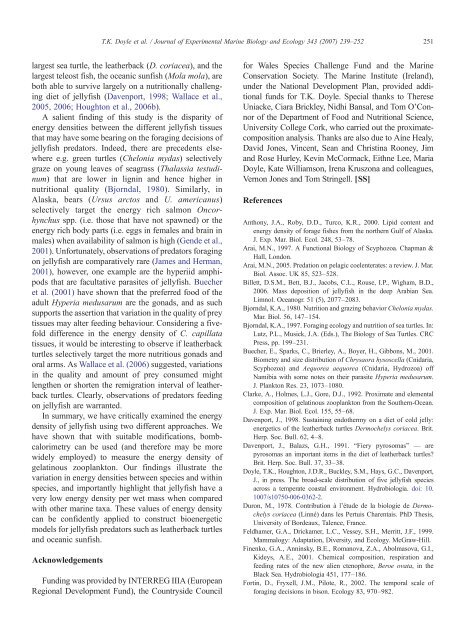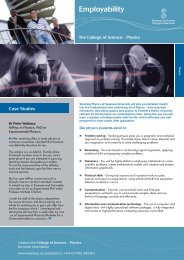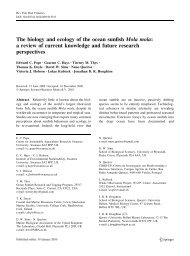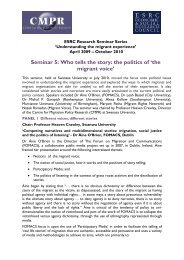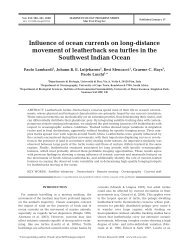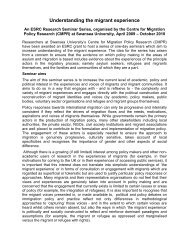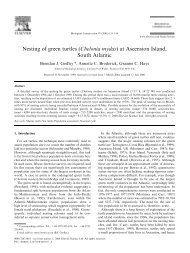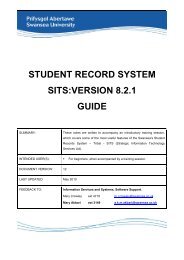The energy density of jellyfish - Swansea University
The energy density of jellyfish - Swansea University
The energy density of jellyfish - Swansea University
You also want an ePaper? Increase the reach of your titles
YUMPU automatically turns print PDFs into web optimized ePapers that Google loves.
T.K. Doyle et al. / Journal <strong>of</strong> Experimental Marine Biology and Ecology 343 (2007) 239–252<br />
251<br />
largest sea turtle, the leatherback (D. coriacea), and the<br />
largest teleost fish, the oceanic sunfish (Mola mola), are<br />
both able to survive largely on a nutritionally challenging<br />
diet <strong>of</strong> <strong>jellyfish</strong> (Davenport, 1998; Wallace et al.,<br />
2005, 2006; Houghton et al., 2006b).<br />
A salient finding <strong>of</strong> this study is the disparity <strong>of</strong><br />
<strong>energy</strong> densities between the different <strong>jellyfish</strong> tissues<br />
that may have some bearing on the foraging decisions <strong>of</strong><br />
<strong>jellyfish</strong> predators. Indeed, there are precedents elsewhere<br />
e.g. green turtles (Chelonia mydas) selectively<br />
graze on young leaves <strong>of</strong> seagrass (Thalassia testudinum)<br />
that are lower in lignin and hence higher in<br />
nutritional quality (Bjorndal, 1980). Similarly, in<br />
Alaska, bears (Ursus arctos and U. americanus)<br />
selectively target the <strong>energy</strong> rich salmon Oncorhynchus<br />
spp. (i.e. those that have not spawned) or the<br />
<strong>energy</strong> rich body parts (i.e. eggs in females and brain in<br />
males) when availability <strong>of</strong> salmon is high (Gende et al.,<br />
2001). Unfortunately, observations <strong>of</strong> predators foraging<br />
on <strong>jellyfish</strong> are comparatively rare (James and Herman,<br />
2001), however, one example are the hyperiid amphipods<br />
that are facultative parasites <strong>of</strong> <strong>jellyfish</strong>. Buecher<br />
et al. (2001) have shown that the preferred food <strong>of</strong> the<br />
adult Hyperia medusarum are the gonads, and as such<br />
supports the assertion that variation in the quality <strong>of</strong> prey<br />
tissues may alter feeding behaviour. Considering a fivefold<br />
difference in the <strong>energy</strong> <strong>density</strong> <strong>of</strong> C. capillata<br />
tissues, it would be interesting to observe if leatherback<br />
turtles selectively target the more nutritious gonads and<br />
oral arms. As Wallace et al. (2006) suggested, variations<br />
in the quality and amount <strong>of</strong> prey consumed might<br />
lengthen or shorten the remigration interval <strong>of</strong> leatherback<br />
turtles. Clearly, observations <strong>of</strong> predators feeding<br />
on <strong>jellyfish</strong> are warranted.<br />
In summary, we have critically examined the <strong>energy</strong><br />
<strong>density</strong> <strong>of</strong> <strong>jellyfish</strong> using two different approaches. We<br />
have shown that with suitable modifications, bombcalorimetry<br />
can be used (and therefore may be more<br />
widely employed) to measure the <strong>energy</strong> <strong>density</strong> <strong>of</strong><br />
gelatinous zooplankton. Our findings illustrate the<br />
variation in <strong>energy</strong> densities between species and within<br />
species, and importantly highlight that <strong>jellyfish</strong> have a<br />
very low <strong>energy</strong> <strong>density</strong> per wet mass when compared<br />
with other marine taxa. <strong>The</strong>se values <strong>of</strong> <strong>energy</strong> <strong>density</strong><br />
can be confidently applied to construct bioenergetic<br />
models for <strong>jellyfish</strong> predators such as leatherback turtles<br />
and oceanic sunfish.<br />
Acknowledgements<br />
Funding was provided by INTERREG IIIA (European<br />
Regional Development Fund), the Countryside Council<br />
for Wales Species Challenge Fund and the Marine<br />
Conservation Society. <strong>The</strong> Marine Institute (Ireland),<br />
under the National Development Plan, provided additional<br />
funds for T.K. Doyle. Special thanks to <strong>The</strong>rese<br />
Uniacke, Ciara Brickley, Nidhi Bansal, and Tom O'Connor<br />
<strong>of</strong> the Department <strong>of</strong> Food and Nutritional Science,<br />
<strong>University</strong> College Cork, who carried out the proximatecomposition<br />
analysis. Thanks are also due to Aíne Healy,<br />
David Jones, Vincent, Sean and Christina Rooney, Jim<br />
and Rose Hurley, Kevin McCormack, Eithne Lee, Maria<br />
Doyle, Kate Williamson, Irena Kruszona and colleagues,<br />
Vernon Jones and Tom Stringell. [SS]<br />
References<br />
Anthony, J.A., Roby, D.D., Turco, K.R., 2000. Lipid content and<br />
<strong>energy</strong> <strong>density</strong> <strong>of</strong> forage fishes from the northern Gulf <strong>of</strong> Alaska.<br />
J. Exp. Mar. Biol. Ecol. 248, 53–78.<br />
Arai, M.N., 1997. A Functional Biology <strong>of</strong> Scyphozoa. Chapman &<br />
Hall, London.<br />
Arai, M.N., 2005. Predation on pelagic coelenterates: a review. J. Mar.<br />
Biol. Assoc. UK 85, 523–528.<br />
Billett, D.S.M., Bett, B.J., Jacobs, C.L., Rouse, I.P., Wigham, B.D.,<br />
2006. Mass deposition <strong>of</strong> <strong>jellyfish</strong> in the deep Arabian Sea.<br />
Limnol. Oceanogr. 51 (5), 2077–2083.<br />
Bjorndal, K.A., 1980. Nutrition and grazing behavior Chelonia mydas.<br />
Mar. Biol. 56, 147–154.<br />
Bjorndal, K.A., 1997. Foraging ecology and nutrition <strong>of</strong> sea turtles. In:<br />
Lutz, P.L., Musick, J.A. (Eds.), <strong>The</strong> Biology <strong>of</strong> Sea Turtles. CRC<br />
Press, pp. 199–231.<br />
Buecher, E., Sparks, C., Brierley, A., Boyer, H., Gibbons, M., 2001.<br />
Biometry and size distribution <strong>of</strong> Chrysaora hysoscella (Cnidaria,<br />
Scyphozoa) and Aequorea aequorea (Cnidaria, Hydrozoa) <strong>of</strong>f<br />
Namibia with some notes on their parasite Hyperia medusarum.<br />
J. Plankton Res. 23, 1073–1080.<br />
Clarke, A., Holmes, L.J., Gore, D.J., 1992. Proximate and elemental<br />
composition <strong>of</strong> gelatinous zooplankton from the Southern-Ocean.<br />
J. Exp. Mar. Biol. Ecol. 155, 55–68.<br />
Davenport, J., 1998. Sustaining endothermy on a diet <strong>of</strong> cold jelly:<br />
energetics <strong>of</strong> the leatherback turtles Dermochelys coriacea. Brit.<br />
Herp. Soc. Bull. 62, 4–8.<br />
Davenport, J., Balazs, G.H., 1991. “Fiery pyrosomas” — are<br />
pyrosomas an important items in the diet <strong>of</strong> leatherback turtles?<br />
Brit. Herp. Soc. Bull. 37, 33–38.<br />
Doyle, T.K., Houghton, J.D.R., Buckley, S.M., Hays, G.C., Davenport,<br />
J., in press. <strong>The</strong> broad-scale distribution <strong>of</strong> five <strong>jellyfish</strong> species<br />
across a temperate coastal environment. Hydrobiologia. doi: 10.<br />
1007/s10750-006-0362-2.<br />
Duron, M., 1978. Contribution à l'étude de la biologie de Dermochelys<br />
coriacea (Linné) dans les Pertuis Charentais. PhD <strong>The</strong>sis,<br />
<strong>University</strong> <strong>of</strong> Bordeaux, Talence, France.<br />
Feldhamer, G.A., Drickamer, L.C., Vessey, S.H., Merritt, J.F., 1999.<br />
Mammalogy: Adaptation, Diversity, and Ecology. McGraw-Hill.<br />
Finenko, G.A., Anninsky, B.E., Romanova, Z.A., Abolmasova, G.I.,<br />
Kideys, A.E., 2001. Chemical composition, respiration and<br />
feeding rates <strong>of</strong> the new alien ctenophore, Beroe ovata, in the<br />
Black Sea. Hydrobiologia 451, 177–186.<br />
Fortin, D., Fryxell, J.M., Pilote, R., 2002. <strong>The</strong> temporal scale <strong>of</strong><br />
foraging decisions in bison. Ecology 83, 970–982.


